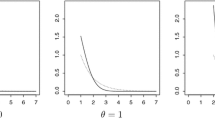Abstract
One purpose of many regression studies is to compare the relative importance of the independent variables. Several different measures have been used to measure importance:t-values, standardized regression coefficients, elasticity, commonality analysis, increment inR 2, correlation coefficients, hierarchical partitioning etc. Some of these measures have the common feature of partitioningR 2 between the independent variables and assess their importance according to their contribution toR 2. This paper is an attempt to clarify the advantages and disadvantages with these different methods and find out if any useful information can be gained by a partitioning ofR 2.
Similar content being viewed by others
References
Bertrand, B. and Holder, R. (1988). A quirk in multiple regression: the whole can be greater than the sum of its parts,The Statistician 37: 371–374.
Blalock, H. M. (1961). Evaluating the relative importance of variables,American Sociological Review 26: 866–874.
Chase, C. I. (1960). Computation of variance accounted for in multiple regression,Journal of Experimental Education 28(3): 265–266.
Chevan, A. and Sutherland, M. (1991). Hierarchical partitioning,The American Statistician 45(2): 90–96.
Darlington, R. B. (1990).Regression and Linear Models. New York: McGraw-Hill.
Freedman, D. A. (1987). As others see us: a case study in path analysis (with discussion),Journal of Educational Statistics 12(2).
Hamilton, D. (1987). SometimesR 2>r 2 yx1 +r 2 yx2 , correlated variables are not always redundant,The American Statistician 41: 129–132.
Hoffman, P. J. (1960). The paramorphic representation of clinical judgement,Psychological Bulletin 57(2): 116–131.
Hoffman, P. J. (1962). Assessment of the independent contributions of predictors,Psychological Bulletin 59(1): 77–80.
Hooker, R. H. (1907). Correlation of the weather and crops,J. R. Statistics Soc. 70: 1.
Kruskal, W. (1987). Relative importance by averaging over orderings,The American Statistician, 1987, 41: 6–10.
Leigh, J. P. (1988). Assessing the importance of an independent variable in multiple regression: is stepwise unwise?J. Clin. Epidemiol. 41(7): 669–677.
Mayeskeet al. (1969).Our Nation's Schools, Washington, D.C. U.S. Office of Education.
Mood, A. M. (1969). Macro-analysis of the American educational system,Operations Research 17: 770–784.
Mood, A. M. (1971). Partitioning variance in multiple regression analysis as a tool for developing learning models,American Educational Research Journal 8: 191–202.
Pedhazur, Elazar J. (1982).Multiple Regression in Behavioral Research (2nd ed.), New York: Holt, Rinehart & Winston. [First edition (1973) was written with Fred N. Kerlinger.
Pratt, J. W. (1987). Dividing the indivisible: using simple symmetry to partition variance explained, in T. Pukkila and S. Puntanen (eds.),Proceeding of the 2nd International Tampere Conference, University of Tampere, 1987, pp. 245–260.
Schey, H. M. (1993). The relationship between the magnitudes of SSR(x 2) and SSR(x 2x1): a geometric description,The American Statistician 47(1), 26–30.
Stewart, T. R. (1988). Judgment analysis: procedures, in Brehmer, B. and C. R. B. Joyce, (eds.),Human Judgement: The SJT view, Chapter 2, Amsterdam: Elsevier Science Publishers B.V.
Tukey, J. W. (1954) Causation, regression, and path analysis, in O. Kempthorneet al. (eds.),Statistics and Mathematics in Biology, Ames: Iowa State College Press, pp. 35–66.
Williams E. J. (1978). Linear hypotheses: regression, in W. H. Kruskal and J. M. Tanur (eds.),International Encyclopedia of Statistics, New York, The Free Press.
Author information
Authors and Affiliations
Rights and permissions
About this article
Cite this article
Bring, J. Variable importance by partitioningR 2 . Qual Quant 29, 173–189 (1995). https://doi.org/10.1007/BF01101897
Issue Date:
DOI: https://doi.org/10.1007/BF01101897




